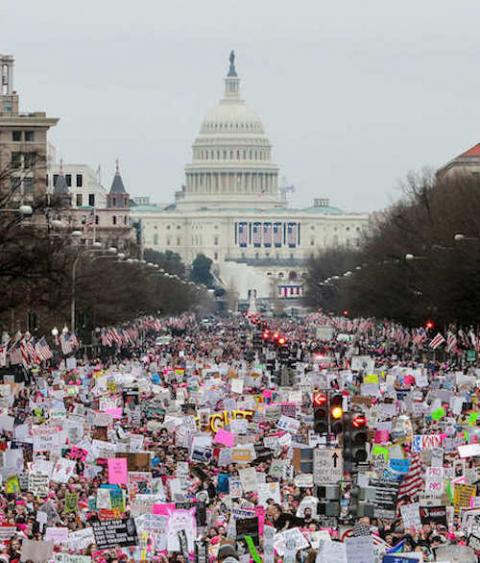- The Future of the Left Is Female – Rebecca Traister (New York Magazine)
- What's Next For the Women's March? Organizer Linda Sarsour Explains. – Isis Madrid (PRI's The World)
- Palestinian-American Behind Women's March Attacked by Right-wing for Being 'Hamas Supporter' - Taly Krupkin (Haaretz)
- Men at the Women’s March? You Bet. Here's Why They Came. – Naomi Shavin (Vox)
- Why we Protested in Solidarity With the Women's March on Washington – Carmen Fishwick, Caroline Bannock and Guardian readers (Guardian)
- Women For and Against Trump Discuss Women’s Rights in a Post-Obama America – Hanna Kozlowska (Quartz)
- The 25 Most Memorable Protest Signs From the Women's March – Dylan Stableford (Yahoo News)
The Future of the Left Is Female
By Rebecca Traister
January 23, 2017
New York Magazine
A lot of people predicted that women were going to change America’s political history in January of 2017. But pretty much no one anticipated that they’d be doing it as leaders of the resistance. On Saturday, millions of women and men — organized largely by young women of color — staged the largest one-day demonstration in political history, a show of international solidarity that let the world know that women will be heading up the opposition to Donald Trump and the white patriarchal order he represents. Women — and again, especially women of color, always progressivism’s most reliable and least recognized warriors, the women who did the most to stop the rise of Trump — were the ones taking progressive politics into the future.
What's Next For the Women's March? Organizer Linda Sarsour Explains.
January 23, 2017
By Isis Madrid
PRI's The World
"There are already things happening right after the march," explains Linda Sarsour, executive director of the Arab American Organization of New York, and co-chair of the Women's March on Washington.
On Sunday, about 500 women in the DC area attended "Ready to Run," a training event for women who wish to run for political office. To make it happen, organizers partnered with groups that reflected the inclusive ethos of the march: EMILY’s List, the Latino Victory Fund, the Gay & Lesbian Victory Institute, The New American Leaders Project, Higher Heights for America, the Asian American Action Fund and Emerge America.
On its official website, march organizers are keeping things moving with their newly launched "10 Actions/100 Days" program, a plan to sustain the activism sparked by the marches.
"Now is not the time to hang up our marching shoes," reads the website. "It’s time to get our friends, family and community together and make history."
Palestinian-American Behind Women's March Attacked by Right-wing for Being 'Hamas Supporter'
By Taly Krupkin
January 24, 2017
Haaretz
"A supporter of Hamas and sharia law" – that was how Linda Sarsour, a Palestinian-American activist, was labeled on social media after she pledged her solidarity as a "Palestinian Muslim sister" with the hundreds of thousands attending Saturday's Women’s March on Washington, of which she was one of the organizers.
Following the accusations, Sarsour asked for support on Twitter, leading human rights leaders and fellow marchers to stand up for her side with a viral campaign on Twitter.
Men at the Women’s March? You Bet. Here's Why They Came.
By Naomi Shavin
January 22, 2017
Vox
There were arguments about whether men were welcome in general. Even men who wanted to attend didn’t know the march was inclusive to them, since the name and platform were centered on women. Any confusion leading up to the march about who it was for, who could participate, and why it was important to show up in person, though, was sorted out by Saturday. Men arrived at the National Mall on Saturday morning to rally for women and gender equality, and also stand up for other marginalized groups and pressing issues.
Trump’s misogynistic campaign demeaned not only women, but essentially every minority group in the country. The Women’s March became a meeting point for people from many marginalized groups, like Victor Yang, to raise their voices. “I really think we need equality for all, and on top of that I’m a minority, so I feel this isn’t just a march for women, it’s also a march for minorities to demonstrate to the new president that he has to keep us in mind,” he said.
Why we Protested in Solidarity With the Women's March on Washington
By Carmen Fishwick, Caroline Bannock and Guardian readers
January 22, 2017
Guardian
Up to 2 million people marched in cities around the world in solidarity with the Women’s March on Washington. Although not specifically billed as protests against the inauguration of Donald Trump, the vast majority highlighted issues they saw as under threat from the new US administration.
Women For and Against Trump Discuss Women’s Rights in a Post-Obama America
By Hanna Kozlowska
January 22, 2017
Quartz
The women who descended on Washington, DC, this weekend could be categorized by their headwear: red baseball caps versus knit pink hats shaped like cat ears. For the former, the main event was Friday’s inauguration of US president Donald Trump, for the latter, it was the Women’s March to protest for women’s rights and against the new president.
In many ways, the two crowds could not be more different, but, as women living in America in 2017, they do share some similar experiences.
The 25 Most Memorable Protest Signs From the Women's March
By Dylan Stableford
January 22, 2017
Yahoo News
Millions of people in cities around the world gathered in support of women’s rights on Saturday. And they were armed with signs in protest of President Trump, mocking both Trump’s past treatment of women and controversial statements he made on the campaign trail.
Below are some of the most clever and colorful signs spotted during Saturday’s historic marches in Washington, D.C., New York City and elsewhere.


Spread the word